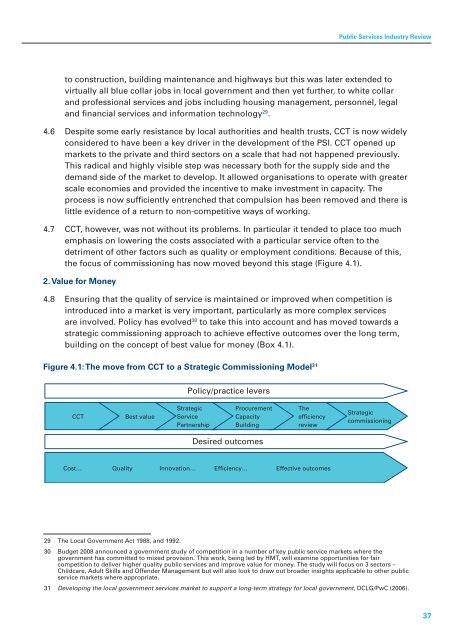Understanding the Public Services Industy
Understanding the Public Services Industy
Understanding the Public Services Industy
You also want an ePaper? Increase the reach of your titles
YUMPU automatically turns print PDFs into web optimized ePapers that Google loves.
<strong>Public</strong> <strong>Services</strong> Industry Review<br />
to construction, building maintenance and highways but this was later extended to<br />
virtually all blue collar jobs in local government and <strong>the</strong>n yet fur<strong>the</strong>r, to white collar<br />
and professional services and jobs including housing management, personnel, legal<br />
and financial services and information technology 29 .<br />
4.6 Despite some early resistance by local authorities and health trusts, CCT is now widely<br />
considered to have been a key driver in <strong>the</strong> development of <strong>the</strong> PSI. CCT opened up<br />
markets to <strong>the</strong> private and third sectors on a scale that had not happened previously.<br />
This radical and highly visible step was necessary both for <strong>the</strong> supply side and <strong>the</strong><br />
demand side of <strong>the</strong> market to develop. It allowed organisations to operate with greater<br />
scale economies and provided <strong>the</strong> incentive to make investment in capacity. The<br />
process is now sufficiently entrenched that compulsion has been removed and <strong>the</strong>re is<br />
little evidence of a return to non-competitive ways of working.<br />
4.7 CCT, however, was not without its problems. In particular it tended to place too much<br />
emphasis on lowering <strong>the</strong> costs associated with a particular service often to <strong>the</strong><br />
detriment of o<strong>the</strong>r factors such as quality or employment conditions. Because of this,<br />
<strong>the</strong> focus of commissioning has now moved beyond this stage (Figure 4.1).<br />
2. Value for Money<br />
4.8 Ensuring that <strong>the</strong> quality of service is maintained or improved when competition is<br />
introduced into a market is very important, particularly as more complex services<br />
are involved. Policy has evolved 30 to take this into account and has moved towards a<br />
strategic commissioning approach to achieve effective outcomes over <strong>the</strong> long term,<br />
building on <strong>the</strong> concept of best value for money (Box 4.1).<br />
Figure 4.1: The move from CCT to a Strategic Commissioning Model 31<br />
Policy/practice levers<br />
CCT<br />
Best value<br />
Strategic<br />
Service<br />
Partnership<br />
Procurement<br />
Capacity<br />
Building<br />
The<br />
efficiency<br />
review<br />
Strategic<br />
commissioning<br />
Desired outcomes<br />
Cost… Quality Innovation… Efficiency… Effective outcomes<br />
29 The Local Government Act 1988, and 1992.<br />
30 Budget 2008 announced a government study of competition in a number of key public service markets where <strong>the</strong><br />
government has committed to mixed provision. This work, being led by HMT, will examine opportunities for fair<br />
competition to deliver higher quality public services and improve value for money. The study will focus on 3 sectors –<br />
Childcare, Adult Skills and Offender Management but will also look to draw out broader insights applicable to o<strong>the</strong>r public<br />
service markets where appropriate.<br />
31 Developing <strong>the</strong> local government services market to support a long-term strategy for local government, DCLG/PwC (2006).<br />
37
















